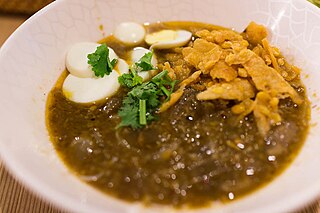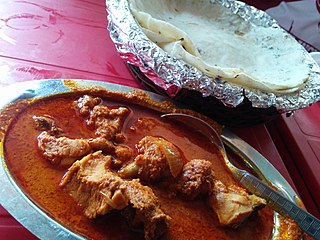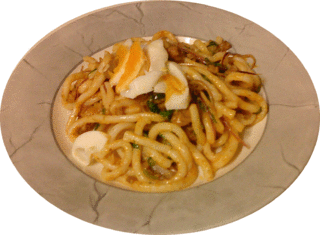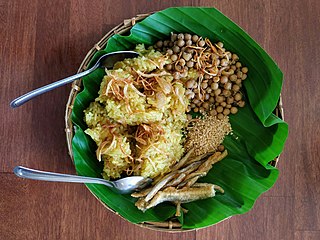
A cookbook or cookery book is a kitchen reference containing recipes.

Jane Grigson was an English cookery writer. In the latter part of the 20th century she was the author of the food column for The Observer and wrote numerous books about European cuisines and traditional British dishes. Her work proved influential in promoting British food.

A falooda is a Mughlai cuisine version of a cold dessert made with vermicelli. It has origins in the Persian dish faloodeh, variants of which are found across West, Central, and South Asia. Traditionally it is made by mixing rose syrup, vermicelli, and sweet basil seeds with milk, often served with ice cream. The vermicelli used for preparing falooda is made from wheat, arrowroot, cornstarch, or sago.

Burmese cuisine encompasses the diverse regional culinary traditions of Myanmar, which have developed through longstanding agricultural practices, centuries of sociopolitical and economic change, and cross-cultural contact and trade with neighboring countries at the confluence of South Asia, Southeast Asia, and East Asia, including the modern-day nations of India, China, and Thailand.

Mohinga is a rice noodle and fish soup from Myanmar and an essential part of Burmese cuisine, considered by many to be the national dish of Myanmar. Mohinga is readily available in most parts of the country, sold by street hawkers and roadside stalls in larger cities. Mohinga is traditionally eaten for breakfast, but today is eaten at any time of day.
Ching-He Huang (Chinese: 黃瀞億; pinyin: Huáng Jìngyì; Wade–Giles: Huang2 Ching4-i4;, often known in English-language merely as Ching, is a Taiwanese-born British food writer and TV chef. She has appeared in a variety of television cooking programmes, and is the author of nine best-selling cookbooks. Ching is recognized as a foodie entrepreneur, having created her own food businesses. She has become known for Chinese cookery internationally through her TV programmes, books, noodle range, tableware range, and involvement in many campaigns and causes.

Burmese tofu is a food of Shan origin and of Chinese from Yunnan state, made from water and flour ground from yellow split peas and the Burmese version of chickpea flour, also known as besan flour, in a fashion similar to polenta. The flour is mixed with water, turmeric, and a little salt and heated, stirring constantly, until it reaches a creamy consistency. It is then transferred into a tray and allowed to set. It can also be made using dried chickpea instead of processed flour. In this process, dried chickpeas are soaked overnight. Once the peas have been re-hydrated, they are ground into a puree with some of the liquid used to soak the peas, then allowed to set for a couple of hours. Much of the top layer of clear liquid is then skimmed off and the remaining puree is brought to a boil with turmeric and salt and cooked and set in the same manner as the version using chickpea flour. It is matte yellow in colour, jelly-like but firm in consistency, and does not crumble when cut or sliced. It may be eaten fresh as a Burmese tofu salad or deep-fried into a Burmese fritter. It may also be sliced and dried to make crackers for deep frying. Despite the name, Burmese tofu is unrelated to Chinese tofu, which is made from soy milk with added coagulants.

Chicken curry is a dish originating from India. It is common in the Indian subcontinent, Southeast Asia, Great Britain, Caribbean, and Japan. A typical curry from the Indian subcontinent consists of chicken stewed in an onion- and tomato-based sauce, flavoured with ginger, garlic, tomato puree, chilli peppers and a variety of spices, often including turmeric, cumin, coriander, cinnamon, and cardamom. Outside of South Asia, chicken curry is often made with a pre-made spice mixture known as curry powder.

Ravinder Bhogal is a food writer, restaurateur, British chef, journalist and stylist. She opened her first restaurant Jikoni in Marylebone, London in September 2016.

Nan gyi thoke is an a thoke salad dish in Burmese cuisine, made with thick round rice noodles mixed with specially prepared chicken curry and chili oil. The dish is garnished with toasted chickpea flour, sliced onions, chilis, crispy noodles, slices of hard-boiled egg, fish cakes, and zested with lime or lemon. The noodle salad originated as a street food from Mandalay.

Gram flour or besan is a pulse flour made from chana daal or brown/kaala chana, a chickpea. It is a staple ingredient in the cuisine of the Indian subcontinent, including in Indian, Bangladeshi, Burmese, Nepali, Pakistani, Sri Lankan and Caribbean cuisines.
Yasmin Khan is a British author, broadcaster and human rights campaigner. Her work covers food, travel and politics and her critically acclaimed books, The Saffron Tales and Zaitoun, use everyday stories to challenge stereotypes of the Middle East.

Shwe yin aye is a traditional Burmese dessert commonly associated with the Thingyan season.

Burmese fritters are traditional fritters consisting of vegetables or seafood that have been battered and deep-fried. Assorted fritters are called a-kyaw-sone. Burmese fritters are generally savory, and often use beans and pulses, similar to South Asian vada.

Sanwin makin is a traditional Burmese dessert or mont, popularly served during traditional donation feasts, satuditha feasts, and as a street snack. The dessert bears resemblance to desserts in neighboring India, where it is called sooji halwa, and Thailand, where it is called khanom mo kaeng.

Hsi htamin is a traditional Burmese snack or mont, popularly served as a breakfast dish, often served alongside peas or dried fish.

Burmese curry refers to a diverse array of dishes in Burmese cuisine that consist of protein or vegetables simmered or stewed in an aromatic curry base. Burmese curries generally differ from other Southeast Asian curries in that Burmese curries make use of dried spices in addition to fresh herbs and aromatics, and are often milder. Burmese curries are readily available in curry houses throughout the country. They are traditionally accompanied with rice and a variety of side dishes, soups, and Burmese salads called athoke. Burmese curries may also be paired with Indian breads like nanbya, palata, aloo puri, and toshay.

Joudie Kalla is a Palestinian-British chef and food writer. She is the author of two prizewinning cookbooks, Palestine on a Plate: Memories from My Mother’s Kitchen (2016), and Baladi: A Celebration of Food from Land and Sea (2018), and has featured in venues like The New York Times,The Guardian, and Al Jazeera.

The Rangoon Sisters: Recipes from our Burmese Family Kitchen is a Burmese cookbook written by British-Burmese sisters Amy and Emily Chung. The book was published by Ebury Press in July 2020 and has been named one of National Geographic's 12 best cookbooks of 2020, one of The Times of India's top culinary books of 2020, and one of The Observer Food Monthly's top 10 great food books of 2020, as well as being shortlisted for the Debut Cookery Book category in the Fortnum & Mason 2021 Food and Drink Awards.

Thua nao, also known as pè bok, is a fermented soybean product used in Burmese and Thai cuisine, particularly by the Shan, Tai Lue, and Northern Thai peoples as a cooking ingredient or condiment. Thua nao is created by fermenting cooked soybeans with naturally occurring microbes.


















